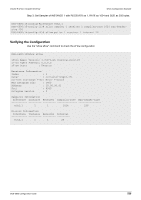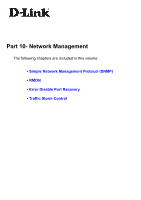D-Link DGS-6600-48TS Configuration Guide - Page 523
most delay a sample by 1 second before it is required to send the datagram. If the 1-second tick
 |
View all D-Link DGS-6600-48TS manuals
Add to My Manuals
Save this manual to your list of manuals |
Page 523 highlights
Volume 9-sFlow / Chapter 52-sFlow sFlow Design Overview When the sFlowFsPacketSamplingRate of a Sampler is set, then that sampling rate should be passed to the switch hardware for the associated interface. Packet samples will be taken and appear for treatment in the Sampler. The Sampler will extract the sampled packets' flow and header information and then pass the information to its Receiver to be encoded into the next output sFlow datagram packet. A sFlowFsPacketSamplingRate of 0 disables the packet sampling. According to sFlow Version 5 section 3.1, this device's hardware samples the packets by generating a random number for each packet, comparing the random number to a preset threshold and takes a sample whenever the random number is smaller than the threshold value. Because of the random number sampling, the number of sampled packets may be different from the sampling rate setting. When the sFlowCpInterval of a Poller is set, the Poller is enabled. A sFlowCpInterval of 0 disables the counter sampling. The Poller uses a random start time between one second and sFlowCpInterval to start the countdown to the first counter sampling, and then samples the counter information every sFlowCpInterval. The random start time prevents the synchronization of counter sampling with other Pollers. When the countdown reaches zero, the Poller gets the counter statistics of the associated interface and then passes the information to its Receiver to be encoded into the next output sFlow datagram packet. The sFlow datagram consists of a header followed by one or more flow or counter samples. The Receiver packs the samples into a contiguous buffer, and sends it out in the next datagram. If the buffer is full and there is no room for the next sample to go into it, then the buffer is sent out and then reset. The sample then becomes the first sample in the next datagram. The sFlow Agent may at most delay a sample by 1 second before it is required to send the datagram. If the 1-second tick comes around and there are samples in the buffer, then the datagram is sent out and the buffer is reset. This is a simple way to ensure that samples are never delayed for more than 1 second in the agent. Each interface may be associated with multiple Samplers with different sampling rates and multiple Pollers with different polling intervals. There is no problem for multiple polling intervals with one interface because the counter sampling is software-based. But the switch is only capable of sampling packets at a single sampling rate. At the situation of multiple sampling rates with a unique interface, the sampling rates must be powers of two to allow the smallest sampling rate to be set in hardware and all other sampling rates to be obtained in software by sub-sampling. DGS-6600 Configuration Guide 523















